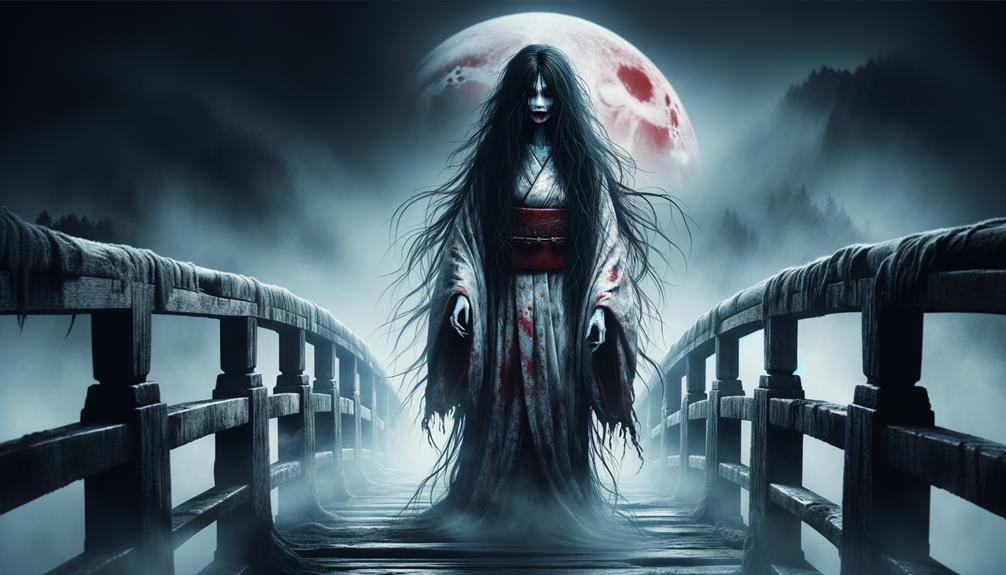Unveiling the Onryo: Japan's Vengeful Spirits
When I first crossed paths with Sadako Yamamura, the unforgettable Onryo from the Ring franchise, I was profoundly affected by her eerie aura and heart-rending narrative. As a researcher engrossed in Japanese folklore, I've devoted years to understanding the Onryo – the vengeful spirits that have been entwined with Japanese mythology for eons.
These spectral entities, often female, are propelled by an intense longing for revenge, a craving so potent that it enables them to defy death and torment their oppressors. Their narratives are not merely horror stories; they also reflect themes of injustice, treachery, and an unquenchable thirst for vengeance that strikes a chord with our most basic human instincts.
Sadako and her Onryo counterparts have been immortalized in contemporary media, but their roots lie deep within traditional Japanese culture. So, what is it about these spirits that captivates us? Why do they linger in our minds and our world, both tangibly and symbolically? Let's set off on an expedition to unravel the wrathful realm of the Onryo.
The Onryo: A Powerful Force in Japanese Mythology
The Onryo, often depicted as women, are motivated by a powerful yearning for revenge, a force so potent that they defy death to torment those who have wronged them. Their tales aren't just horror stories; they're also narratives of injustice, betrayal, and a primal thirst for vengeance.
These spirits, like Sadako Yamamura from the Ring franchise, have firmly carved their place in modern media. However, their origins are deeply embedded in traditional Japanese culture.
Understanding the Allure of the Onryo
What makes these spirits so captivating, and why do they continue to linger in our minds and our world? Is it their eerie presence, their tragic narratives, or their unquenchable thirst for vengeance? Or is it a combination of all these elements?
Our fascination with the Onryo extends beyond the realm of entertainment. It speaks to our primal instincts, our sense of justice, and our fascination with the unknown.
As we delve deeper into the world of the Onryo, let's remember that these are not just tales of terror. They're also narratives of injustice, betrayal, and a primal thirst for vengeance. They remind us of the power of emotion, the enduring nature of the human spirit, and the universal desire for justice. These are the stories that continue to haunt us, both literally and metaphorically, keeping us engrossed and engaged in their chilling tales.
Takeaway
The Onryo form an integral part of Japanese mythology, serving as a stark reminder of the human thirst for justice and vengeance. As we delve deeper into this chilling realm, we learn more about our own primal instincts and the inherent fascination we have with the unknown. Exploring the world of the Onryo promises a journey filled with intrigue, horror, and a profound understanding of human nature.
The Origins of Onryo

The Evolution of Onryō: Japan's Vengeful Ghost
Unraveling the beginnings of the onryō lore, we journey back to the 8th century, specifically within the realm of Prince Nagaya's cult. The Prince's demise in 729 signalled the first recognized emergence of this wrathful spirit concept. This pivotal moment in Japanese folklore unveiled to the world the existence of the revenge-driven specter, known as onryō – a being that emerges from death with a thirst for retribution.
The Unique Nature of Onryō
During this exploration of the ancient narrative, it becomes evident how integral revenge is to the very essence of onryō. These aren't your average spirits or apparitions. Their mission extends beyond mere haunting; they seek to exact tangible harm on those who wronged them in their earthly existence. Their fury can even manifest in the form of catastrophic natural phenomena. This is indeed a compelling, though unnerving, facet of Japanese folklore that encapsulates the human dread of the repercussions of inflicting pain upon others.
Onryō: A Reflection of Universal Fear
The onryō belief, originating from Prince Nagaya's cult, has rippled through the centuries, etching its impact on countless stories, dramas, and even contemporary horror franchises. It's evolved beyond a simple narrative of a revenge-seeking ghost. Rather, it serves as a mirror reflecting the universal apprehension of retribution post-mortem. The onryō isn't merely a phantom; it's the personification of vengeance.
Experience the Onryō Legend Firsthand
For those fascinated by the captivating lore of onryō, I recommend immersing yourself in Japanese dramas like *J-Horror* or movies like *Ringu*. This will provide a firsthand experience of the chilling, yet intriguing nature of this unique element of Japanese folklore. The onryō isn't just a ghost-story, it's a riveting exploration of the psyche's fear of vengeance, making it a must-explore for any folklore enthusiast.
Whether you're a horror aficionado, a folklore scholar, or simply someone intrigued by cultural tales, the onryō narrative is an enthralling journey into the heart of Japanese folklore. It offers a unique perspective on the human fear of retribution and how it shapes our stories and beliefs. Dive into the world of onryō, and discover how this ancient tale continues to leave an indelible mark on modern storytelling.
Characteristics of Vengeful Onryo
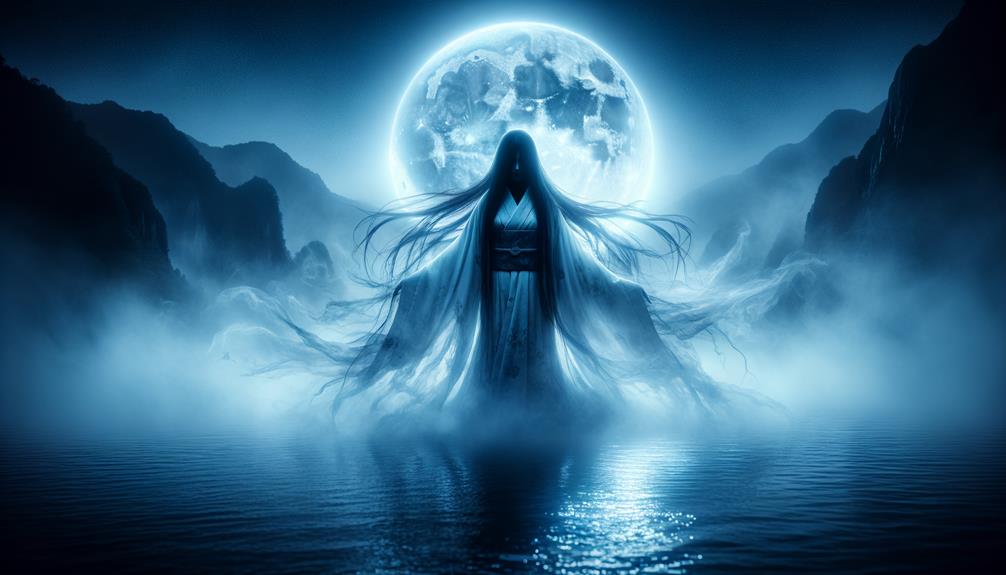
Unraveling the Mystery of the Onryō Vengeful Spirits
Diving deep into the fascinating world of Japanese folklore, we encounter the chilling yet compelling spirits known as Onryō. They are not just spectral manifestations that instill fear but also powerful symbols of justice and retribution. Their distinct characteristics stem from the deep-seated fear of revenge that they embody.
Onryō: The Vengeful Spirits with Distinctive Style
With their long hair flowing like dark rivers, hiding their faces from view, the Onryō present a haunting image indeed. They are often portrayed in white burial garments, floating slightly above the ground. This unsettling depiction adds to their eerie aura, ensuring they leave a lasting impression on anyone who comes across their tales.
Vengeance Beyond the Grave
These spirits are far from being mere phantoms. They possess the uncanny ability to inflict harm on their adversaries and twist destiny to bring about suffering and despair. In some tales, the Onryō even demonstrate the terrifying power of triggering natural calamities, such as earthquakes and fires. This further emphasizes their formidable influence in the realm of Japanese mythology.
Onryō: Reminders of Justice in Folklore
These vengeful spirits serve a dual purpose in Japanese folklore. They are not only elements of terror but also poignant reminders of justice. As a particular type of yūrei, or ghost, they symbolize the repercussions of immoral actions. The tales of Onryō often serve as cautionary stories. They warn against the consequences of treachery and injustice, underlining the potential retribution that can be incurred from these spiteful spirits.
Onryo in Traditional Japanese Folklore
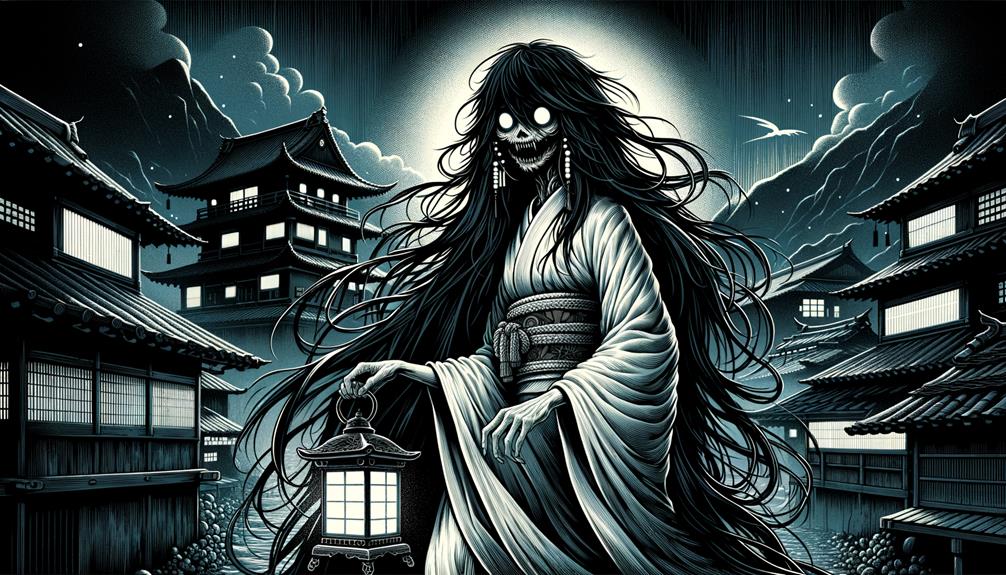
The Onryō: Vengeful Spirits in Japanese Folklore
Within the mystical realm of traditional Japanese folklore, the Onryō, notoriously known as vengeful spirits, relentlessly pursue justice for the misdeeds they encountered during their mortal existence. These wronged souls are driven by an insatiable desire for vengeance, reflecting their wrathful temperament.
The Onryō: Central Figures in Haunting Tales
This vengeful spirit, the Onryō, assumes a pivotal role in numerous spine-chilling tales, like the Yotsuya Ghost story, and even in contemporary adaptations like Sadako Yamamura from the Ring series. These narratives typically portray the Onryō as a mistreated woman, deceived and slain, with her spirit restlessly wandering until she has claimed her revenge.
Visual Representation of the Onryō in Kabuki Theatre
In the dramatic world of Kabuki theatre, the Onryō are often represented in stark white kimonos, complemented by untamed black hair and eerie makeup, a haunting visual as gripping as their stories. The persistent retelling of their tales and the chilling Kabuki performances have cemented the image of the Onryō in popular culture, amplifying their vengeful nature.
Buddhist Prayers: A Path to Peace for the Onryō
Contrasting their wrathful disposition, Buddhist prayers aim to soothe these tormented spirits, offering them the peace they were robbed of during their earthly lives. These prayers serve as a compassionate plea for mercy, imploring the Onryō to let go of their rage and find solace in the afterlife.
Influence of Onryo on Modern Media
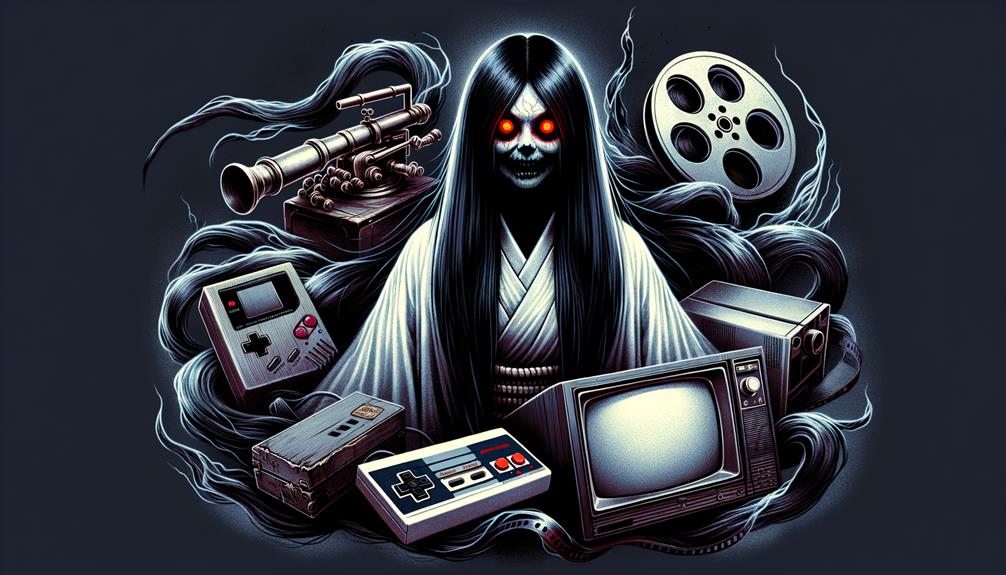
Onryō's Impact on Today's Media Landscape
The spectral presence of the Onryō, rooted deeply in the rich soil of traditional Japanese folklore, has subtly permeated the modern media scene. This influence has been particularly pronounced within the realm of horror, shaping and refining the narratives of the genre in contemporary times. The iconic depiction of the vengeful Japanese spirit, the Onryō, is now an integral part of both Japanese and global horror cinema.
Yotsuya Kaidan: The Tale that Popularized the Onryō Trope
The chilling narrative of Yotsuya Kaidan, an Edo period ghost story centered around Oiwa – an embodiment of the Onryō, has been retold countless times. This repetition speaks volumes about its significant contribution towards popularizing the Onryō trope. Lafcadio Hearn, a renowned interpreter of Japanese culture from abroad, amplified its reach by incorporating this tale into his works.
Modern Horror Films: Onryō's New Age Interpretations
Contemporary horror films, namely 'Ring' and 'Ju-On', have creatively built upon these traditional narratives. They've presented the Onryō, like the haunting figure of Kayako Saeki, as pale, vengeful entities with the ability to warp reality. These portrayals aim not merely to instill fear but to delve deeper into themes of justice, revenge, and the rippling effects of one's actions. These films underscore the timeless cultural significance of the Onryō.
The Enduring Cultural Relevance of the Onryō
Through the lens of modern media, the Onryō continues to maintain its cultural relevance, while providing a unique perspective on the consequences of our actions. Its influence on horror cinema, both domestically and internationally, is a testament to its enduring appeal. The Onryō's journey from traditional folklore to contemporary media narratives demonstrates its ability to adapt and evolve, while retaining its core essence. This evolution is sure to captivate audiences for generations to come.
Notable Examples of Onryo Spirits
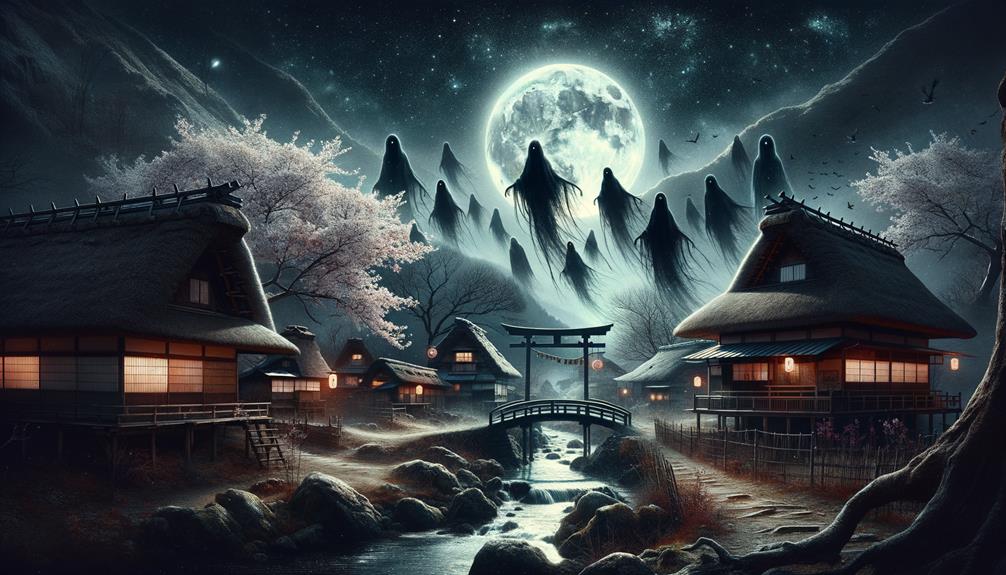
Unearthing the Enticing Realm of Onryō Spirits
Venturing into the fascinating world of Onryō, we discover a captivating collection of revengeful spirits. They've left a lasting imprint on both traditional folklore and modern media. The notable Onryō spirits validate the enduring belief in these malevolent entities, causing both natural disasters and personal vendettas.
Prince Sawara: A Posthumous Reign of Terror
Prince Sawara's spirit is linked with the Fujiwara no Hirotsugu Rebellion and an array of natural catastrophes. The attempts to calm his vengeful spirit in Kyoto illustrate the terrifying power these entities can possess.
Sugawara no Michizane: A Respected Scholar Turned Feared Onryō
Sugawara no Michizane, a highly esteemed scholar and politician, experienced a dark turn of fate. After his banishment and eventual demise, he transformed into a feared Onryō. His spirit now resides in the Tenman-gū shrines, where efforts are made to appease him.
The Tale of the Vengeful Wife
This chilling narrative tells the tale of a woman who, after being betrayed by her husband, morphs into an Onryō spirit. She haunts and seeks revenge on her husband, serving as a stark reminder of the power of vengeance beyond the grave.
These Onryō spirits, these vengeful Japanese specters, encapsulate a potent blend of horror, tragedy, and justice. They are emblematic of this spectral class, their stories echoing through time, demonstrating the unending influence of revenge from beyond.
Their narratives are a testament to the enduring fascination with the supernatural and the power of vengeance. These tales continue to captivate audiences, reflecting the timeless appeal of vengeance beyond the grave. These stories are as relevant today as they were in ancient times, highlighting the universal appeal of such haunting tales.
The world of Onryō is an intriguing realm of the supernatural, filled with fascinating stories of revenge and retribution. So why not delve into these captivating tales and discover for yourself the enthralling power of these vengeful spirits?
Frequently Asked Questions
What Is the Japanese Name for Vengeful Spirit?
Meet the Onryo: Unleashing the Fury of Japan's Wrathful Spirits
Delving into the intriguing realm of Japanese folklore, we come across a term that sends shivers down the spine – 'Onryo'. This *nomenclature* is ascribed to vengeful spirits, a concept deeply embedded in Japan's cultural ethos. Let's dive deeper into the mystic world of these *powerful entities*, their wrathful existence, and their relentless pursuit of retribution.
Onryo: Wrathful Spirits of Japanese Lore
The Onryo are not your run-of-the-mill spirits. They are formidable forces, believed to be the wrathful souls of the deceased. Their primary goal? Seeking retribution. These spirits are not just vengeful; they are powerful enough to even trigger natural disasters. Imagine the sheer power and terror that comes with that!
The Power of the Onryo: From Folklore to Reality
What makes the Onryo fascinating is their uncanny ability to transcend the boundary between folklore and reality. They are not just figments of cultural imagination but have a palpable presence that continues to influence the Japanese psyche.
Engaging with the Onryo: A Cautionary Tale
As we delve deeper into the world of the Onryo, it's important to remember: these are not entities to be trifled with. They are the embodiment of wrath and retribution, powerful enough to cause natural disasters. If you ever find yourself face-to-face with an Onryo, remember this: respect their power, understand their wrath, and tread cautiously.
What Is the Myth of Onryō?
Understanding the Myth of Onryō: A Tale of Vengeful Spirits
The captivating story of Onryō centers around the restless souls of the departed who are said to relentlessly pursue retribution. These spirits, filled with rage from deceit or an untimely demise in their mortal lives, are often linked with causing both widespread calamities and personal suffering.
In the realm of folklore, the Onryō exemplifies a powerful image of vengeful spirits. They are not your typical ghost stories or bedtime fairy tales, but rather, they represent an embodiment of intense anger and resentment, derived from their experiences of betrayal and premature death during their existence on Earth.
These spirits don't just haunt; they wreak havoc. The impact of their wrath can range from personal anguish to large-scale disasters. Imagine a spirit so powerful that its anger could stir up a storm or cause an earthquake – that's the terror of an Onryō.
The Onryō: Spirits of Vengeance
The narrative of Onryō is more than folklore; it paints a vivid picture of the unseen world and the potential power of unresolved emotions. To better understand this concept, consider the equivalent of a psychological thriller, but with supernatural elements.
In terms of real-world examples, think about the Onryō as the tragic heroes in Shakespearean plays, who, despite their death, their thirst for revenge keeps them tied to the mortal world.
In a nutshell, the myth of Onryō offers a fascinating exploration into the world of folklore and the supernatural. It serves as a reminder that actions have consequences, even beyond the grave.
What Are the Powers of Onryō?
Onryō: The Unleashed Powers
Through my scholarly journey into the realm of myths, I've discovered the remarkable powers that onryō possess. These haunting spirits are not merely figments of the imagination, but powerful entities capable of invoking chaos and disruption.
Onryō: Masters of Disaster
Their ability to trigger cataclysms sets them apart from other supernatural beings. Imagine a sudden storm or an unexplained earthquake – these could potentially be the works of an enraged onryō. Their power to instigate disasters displays their limitless potential and their unyielding thirst for retribution.
Onryō: The Invisible Puppeteers
Further delving into their powers, onryō can also take control of unsuspecting individuals. This is not a simple act of possession; it is a meticulous manipulation of one's reality. Picture the horror of having your actions dictated by an unseen force – that's the disturbing power that onryō hold.
Onryō and the Digital Age
Interestingly, the powers of onryō extend into the modern world. They can interfere with electronics, disrupting the very tools that we rely on daily. This is a testament to their adaptability and their ceaseless pursuit of vengeance.
To fully comprehend the powers of onryō, I'd recommend delving into various myths and legends. Reading material like "The Tale of Genji" or even watching movies like "The Ring" will offer a broader understanding of their capabilities.
What Do Onryō Do?
Understanding the Actions of Onryō
At their core, onryō are driven by a powerful thirst for retribution. They're perceived as entities that deliver harm unto those who wronged them, and, shockingly, they're even associated with triggering natural calamities. This stems from their intense yearning for justice, a consequence of the sufferings they experienced during their earthly existence.
Onryō: The Pioneers of Vengeance
To put it plainly, onryō are the embodiment of revenge. The harm they inflict on their adversaries is seen as a form of karmic justice. Incredibly, they're not just limited to targeting individuals – they're also linked with causing natural disasters. The driving force behind their actions? A deep-seated pursuit of justice, a direct result of the injustices they endured in their lifetime.
Why Do Onryō Seek Vengeance?
Fundamentally, the actions of onryō are fueled by a strong desire for revenge. Believed to bring harm to their foes and even incite natural catastrophes, their actions are essentially a quest for justice for the wrongs they suffered while alive.

